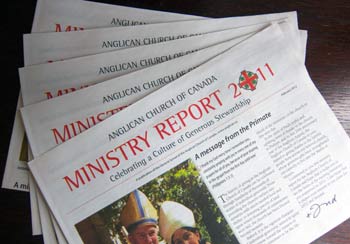As results tally up from the 2011 annual appeals that support national ministries, two things are clear: General Synod has many loyal donors, and the church needs to keep sharing with them its stories of vibrant ministry—from environmental advocacy to training young leaders.

One way the Resources for Mission Department is sharing these stories is through its first Ministry Report, which describes in narrative form how donors’ gifts make a difference on the ground.
The report was distributed with the February edition of the Anglican Journal and is available online. Extra copies are being sent to diocesan centres and executive councils. They can also be ordered from Resources for Mission (see below).
“On behalf of everyone at Church House I am tremendously grateful that so many thousands of faithful people have responded to our invitations this year,” said Michelle Hauser, manager of annual giving.
“With so many worthwhile causes that Anglicans are called to support, we cannot take this loyalty and faithfulness for granted,” she added. “Our challenge and our opportunity is to strengthen our case for support, communicate it well, keep our loyal supporters engaged and attract new supporters.”
Mixed results for appeals
In total, the three national appeals raised more than $1 million for mission work, a figure that while generous, was lower that had been hoped.
The Anglican Journal Appeal, which supports the Anglican Journal and which is shared with diocesan newspapers, raised more than $483,000—a result comparable with previous years.
However the Anglican Appeal—which supports General Synod’s national ministries—continued to decline. In 2011, donors gave just more than $500,000 to the appeal—about $120,000 less than in previous years.
“The Anglican Appeal has struggled, particularly in the last few years with several rounds of budget cuts and staff layoffs at the General Synod,” said Ms. Hauser.
“These cuts were required to achieve a balanced and sustainable budget and were made in the context of the priorities and practices of Vision 2019. But they also left some donors wondering what there is left to support at the national church.”
In fact, Ms. Hauser says, as the Ministry Report demonstrates, General Synod’s ministries are as numerous, as vibrant and as important to God’s mission as ever.
Gifts for Mission, the church’s creative gift guide, grew to more than $102,000 last year—an increase of approximately $13,000 from 2010, its inaugural year. The guide presented gifts from General Synod as well as other entities such as the Anglican Foundation and the Primate’s World Relief and Development Fund (PWRDF).
Haiti, Indigenous ministry, popular this year
The most popular gift guide item was school lunches for children in Haiti (see video below), which brought in more than $12,900. Other popular PWRDF projects included support for HIV/AIDS orphans in South Africa and a seed multiplication project in Burundi.
The Anglican Foundation’s furry Hope Bear also caught donors’ attention. By purchasing $20 Hope Bears, the foundation raised more than $2,300 for children’s ministry.
Donors also sent in more than $3,000 to buy motorcycles for the Iglesia Episcopal de Cuba. This will equip two ministers with two machines.
One clear trend was donors’ interest in Indigenous ministry. Donors supported northern clergy, the national Sacred Circle meeting, and the Suicide Prevention Program for northern Canada.
Ms. Hauser is already planning to expand the gift guide in 2012. She wants to develop a food ministry gift that groups creative bakery and food bank work in several dioceses. She may also seek larger partners to match gifts.
The gift guide also strengthens General Synod’s storytelling by holding up discrete elements of the church’s national work. It allows people to designate their gifts to specific ministries that interest them and to give easily online. So far the response has been good, especially from new donors.
“People are appreciative that we’re finally doing a gift guide,” said Ms. Hauser. “It’s amazing. They write notes. They say ‘I wish I could give more this year.'”
Resources for Mission staff will continue to thank generous donors, with correspondence based on Philippians, which Ms. Hauser calls “the greatest thank you letter in the Bible.”
- Read the ministry report online or order copies from Resources for Mission by contacting Michelle Hauser by email or phone (416) 924-9199 ext. 326.
- Watch a video to learn more about the most popular gift guide item, school lunches in Haiti.
- Missed giving in 2011? You can still give through Gifts for Mission online.
Interested in keeping up-to-date on news, opinion, events and resources from the Anglican Church of Canada? Sign up for our email alerts .
